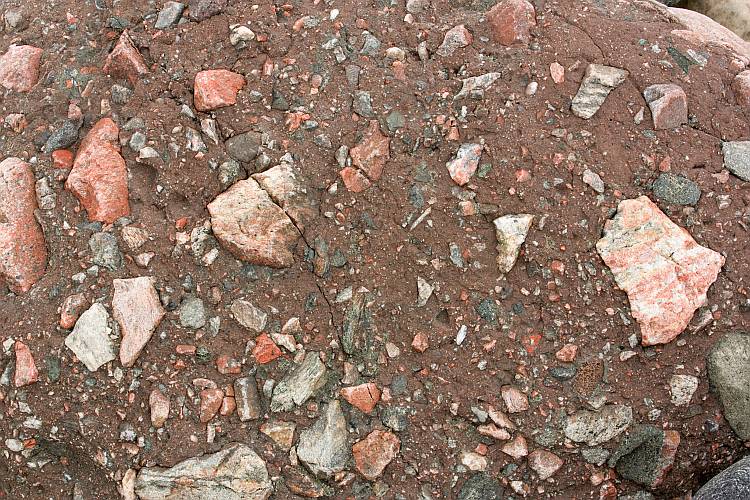Diamictite is a poorly sorted or non-sorted terrigenous non-calcareous sedimentary rock that contains variously sized clasts from clay to boulders in a muddy matrix. Diamicton (or diamict) is a non-lithified diamictite (sediment). The definition above was proposed by Flint et al. in 19601 and it was meant to be and still is purely descriptive without any genetic connotations.
http://picasaweb.google.com/107509377372007544953/2015#6190951862643199218
This rock is sedimentary, it contains larger clasts in a fine-grained matrix-supported groundmass. The material is terrigenous and non-calcareous. It clearly fulfils every criteria of diamictite and it almost certainly is of glaciogenic origin. It is a tillite from the Varangian glaciation. Finnmark, Norway.
There is a need for a descriptive rock definition in this case because the rocks that superficially look alike may form in different ways. In many cases diamictite is a glaciogenic rock tillite. Sometimes diamictite is erroneously considered to be a synonym of tillite. But it may also be a lithified lahar (volcanic mudflow), volcanic flank collapse breccia, it may form underwater as a part of a turbidite flow, it may be composed of dropstones in marine sediments, etc. These are all lumped together under an umbrella term diamictite.
That, however, creates a problem because modern geology strives to explain how rocks and sediments form(ed). It is not enough if we simply describe them. From that point of view “diamictite” does not fit well into contemporary science. Every time someone uses the term, the question of genesis immediately arises. “Diamictite” has its role in the field, though. It continues to be useful as a preliminary term to describe rocks with a certain appearance.
The majority of rocks named so seem to be glaciogenic. Glaciers carry all sorts of material from clay to large rocks scraped from the ground as the ice advances. There are no mechanisms to sort them according to size. As ice melts, all this non-sorted debris is left behind as a sediment known as till. Once till is buried and lithified, it becomes sedimentary rock tillite, which may be described by scientists as diamictite if they are not certain about its origin.
Sometimes there are large boulders in fine marine sedimentary rocks. These rocks may be dropstones that fell vertically through the water column and were released by melting icebergs or perhaps even ejected from volcanoes as volcanic bombs. The term tillite clearly does not apply in this case. Ancient lithified mudflows are another way to produce rocks that can be described as a matrix-supported (clasts are generally isolated from each other by a muddy matrix) mixture of variously sized material. “Diamictite” that is free of any genetic connotations is a handy way to name these rocks before we know more about them.
http://picasaweb.google.com/107509377372007544953/2015#6190951841789008210
Varangian diamictite (tillite) with a large boulder. Finnmark, Norway.
http://picasaweb.google.com/107509377372007544953/2015#6208017878062824578
Lithified tillite near the Vatnajökull glacier in Iceland. Width of sample 30 cm.
http://picasaweb.google.com/107509377372007544953/2015#6190952526986046658
Glacial dropstones in a fine-grained marine sedimentary rock from Morocco. Clasts are over 10 cm in diameter.
http://picasaweb.google.com/107509377372007544953/2015#6208017964302556642
An outcrop of diamictite in Morocco with glacial dropstones.
http://picasaweb.google.com/107509377372007544953/2015#6208017879252573874
A sample from a lithified Carboniferous lahar deposit from Ireland. Width of sample 9 cm.
http://picasaweb.google.com/107509377372007544953/2015#6208017911538443714
Volcanic debris avalanche that forms when gravitationally unstable flank of a steep volcanic edifice partially collapses is a non-sorted mixture of variously sized clasts in a muddy matrix. This outcrop is in St. Lucia (the Lesser Antilles).

Diamictite in northern Norway. It is most likely of glacial origin (tillite). Varanger Peninsula. Width of view 50 cm.
http://picasaweb.google.com/107509377372007544953/2015#6190951642304045202
Diamictite (tillite) from Norway that funnily resembles dead fish. Varanger Peninsula. Width of sample 40 cm.
http://picasaweb.google.com/107509377372007544953/2015#6196127056056475394
A sample of diamictite carrying clasts of igneous and metamorphic rocks. Varanger Peninsula, Norway. Width of sample 16 cm.
http://picasaweb.google.com/107509377372007544953/Tenerife#5835129403524547218
Diamictite or a matrix-supported breccia from Tenerife. This mixture is located in the Las Cañadas caldera and probably is a result of the formation process of the caldera. Width of view 1.7 meters.
References
1. Flint, R. F. (1960). Diamictite, a substitute term for symmictite. Geological Society of America. Bulletin, volume 71, page 1809.
Leave a Reply